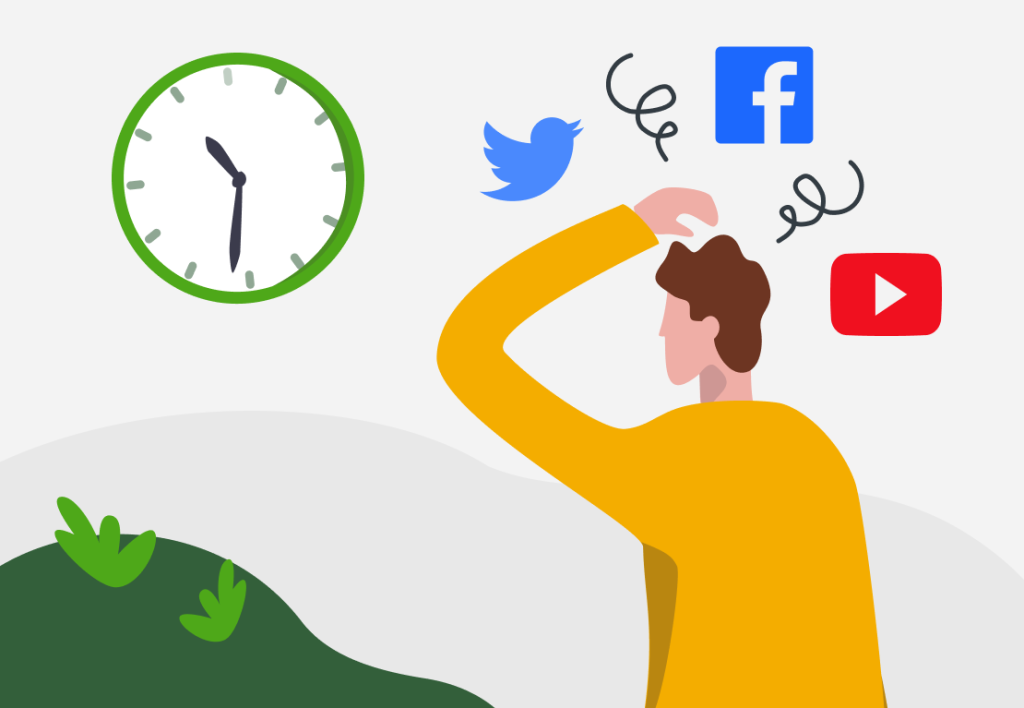YouTube, Facebook, WhatsApp – biggest time wasters at work in 2022

Which websites helped us work, and which were the biggest time wasters at work in 2022?
Last year, DeskTime tracked close to 430 thousand working hours. We took a look at how this time was spent and listed the top 10 most used productive and unproductive websites and apps at work.
Note: DeskTime allows users to label different apps and websites according to how they perceive them – either as productive or unproductive. That means that what’s considered productive for one can be seen as unproductive for someone else.
Boost your team’s productivity!
Try DeskTime for free
Try free for 14 days · No credit card required.
By signing up, you agree to our terms and privacy policy.

Top 10 biggest time wasters at work in 2022
New year, new me, right?
Wrong.
Years change, but our unproductive habits remain – for the third year in a row, the top three biggest time wasters at work were YouTube, Facebook, and Whatsapp. The rest of the top hasn’t changed much either, and here’s what it tells us:
- People are looking to inject a bit of fun into their workday with streaming apps and social media
- YouTube has become an integral part of our workday – and its use is not always just a waste of time
- There’s still no consensus among employers on the productivity of instant messaging
Before we take a closer look at the conclusions, here are the top time wasters in the workplace in 2022, compared to 2021 and 2020.
| # | 2022 | 2021 | 2020 |
| 1 | YouTube | YouTube | YouTube |
| 2 | |||
| 3 | |||
| 4 | Netflix | Skype | Amazon |
| 5 | Spotify | Netflix | |
| 6 | Skype | VLC Media Player | |
| 7 | Spotify | Windows Media Player | |
| 8 | Slack | VLC Media player | Spotify |
| 9 | Amazon | Amazon | Netflix |
| 10 | VLC Media Player | Slack | Quora |
1. People are looking to inject a bit of fun into their workday
With the rise of remote work and flexible schedules, people are increasingly seeking ways to balance their professional and personal lives. Hence, websites and apps such as Netflix, Spotify, and Amazon have taken a stable place on the list since the start of the Covid-19 pandemic.
The use of such websites during working hours doesn’t necessarily mean people aren’t taking their jobs seriously. Rather, it indicates that employees, especially those working remotely, are looking to have a break and unwind with some entertainment – either with quick shopping, an episode of one’s favorite TV show, or discovering a new music playlist.
At the end of the day, if your team can balance work and play, a little bit of fun at work may not be such a bad thing. It’s their way to disconnect and take a break. And even though spending a work break at the computer might not be the recommended way, as long as it helps your employees come back more relaxed and focused, you shouldn’t object.

2. YouTube – not always a time waster in the office
For years, YouTube has been at the top of the list of the most used non-productive applications. While it’s easy to get sucked in the vortex of funny cat videos and movie trailers, many will agree – it’s not always just a waste of time.
YouTube is often called the second most popular search engine after Google, and employees, too, often use it to search for relevant information for the task at hand. Additionally, experts have noted that educational videos and how-to guides are among the most watched types of videos on YouTube. So, if watching such videos to learn a new skill or research a topic can help people do their jobs more effectively, why not allow it?
3. There’s no consensus on the productivity of instant messaging
In 2021, instant messaging apps Skype and Slack first appeared among the most used productive and unproductive apps. This year, the same thing has happened, indicating that there’s still no consensus among employers on whether these tools are good or bad for workplace productivity.
There’s a share of managers who see instant messaging as some of the biggest time wasters in the office. There can be several reasons, for example:
- Instant messaging can be distracting. Message notifications can hinder employee focus, which may lead to a situation where people spend more time checking messages from colleagues and chatting than actually getting things done.
- These tools can cause information overload. Notifications and messages constantly popping up and demanding attention are not just distracting – it can also be overwhelming and stressful.
- High miscommunication risks. Written messages can fail to deliver messages exactly as intended, which can lead to misunderstandings and the need for follow-up conversations. To boost workplace efficiency, managers may want to limit the use of online communication tools and, instead, encourage face-to-face communication by luring teams back to the office.

Identify your team’s biggest time thieves
Eliminate unproductive habits that harm your team’s performance.
Then again, it’s difficult to imagine modern workplaces without the use of instant messaging tools, especially now that many companies offer remote and hybrid work options. These tools enable fast and efficient communication among team members and are vital for remote team collaboration. Hence, Skype and Slack were also among the most used productive apps at work in 2022.
Top 10 most used productive apps at work in 2022
Here’s the full list of websites and apps employees used the most in 2022 that employers have categorized as “productive”.
| # | 2022 | 2021 | 2020 |
| 1 | MS Outlook | MS Outlook | MS Outlook |
| 2 | MS Excel | ||
| 3 | MS Teams | Gmail | MS Excel |
| 4 | MS Excel | Google Docs | Gmail |
| 5 | Google Docs | MS Teams | Google Docs |
| 6 | Gmail | Skype | MS Remote Office |
| 7 | Slack | MS Remote Office | Slack |
| 8 | MS Word | Skype | |
| 9 | Skype | MS Word | MS Word |
| 10 | MS Remote Office | Slack | MS Teams |
Here are the two main conclusions:
1. Communication is the key component of a modern workplace
5 out of the 10 most commonly used productivity apps at work are communication and collaboration tools. This illustrates that a significant portion of our workday is spent communicating with colleagues, partners, and clients to get things done – either via email, video calls, or instant messaging apps.
2. The use of MS Remote Office has dropped as employees returned to the office
In 2022, people started spending more time in the office again. In the US, 34% of employees returned to the office full-time, and another 53% worked in a hybrid manner. This might explain the drop in MS Remote Office usage in 2022.
What to expect in 2023
This year’s top 10 lists didn’t bring any big surprises or unexpected conclusions. Can we expect surprises from the top biggest time-wasters at work in 2023? We can start making bets.
It will certainly be a surprise if ChatGPT won’t be on the list. The only question is, which list? Will employers understand its contribution to employee productivity, or will they see it as another way to waste time in the workplace? We’ll have to wait to find out.
Did you find this article useful? Give it a clap!
Psst! You can clap more than once if you really loved it 🙂